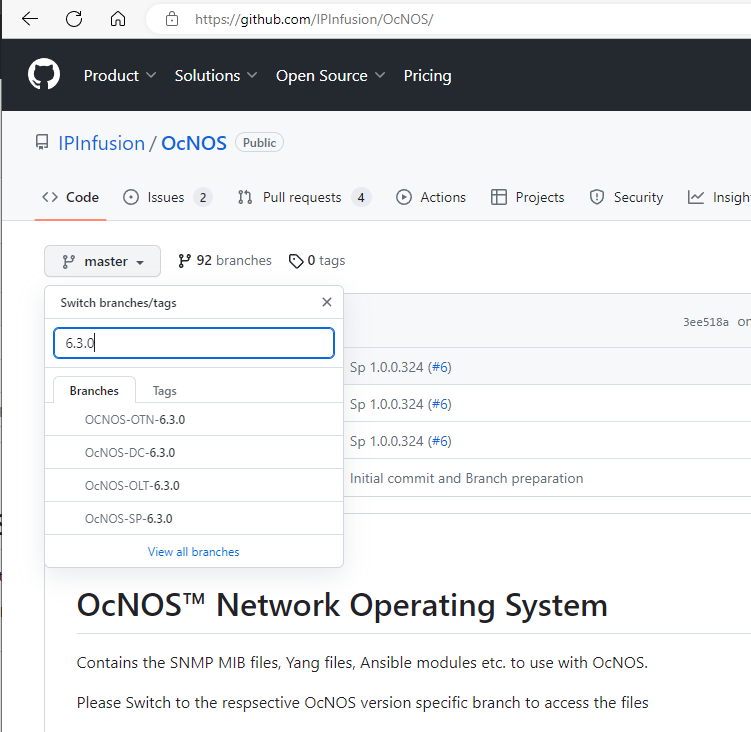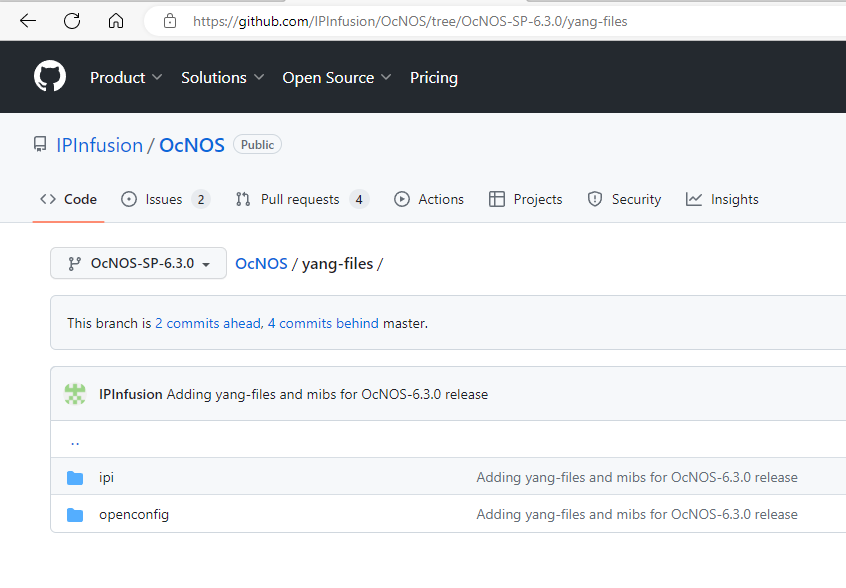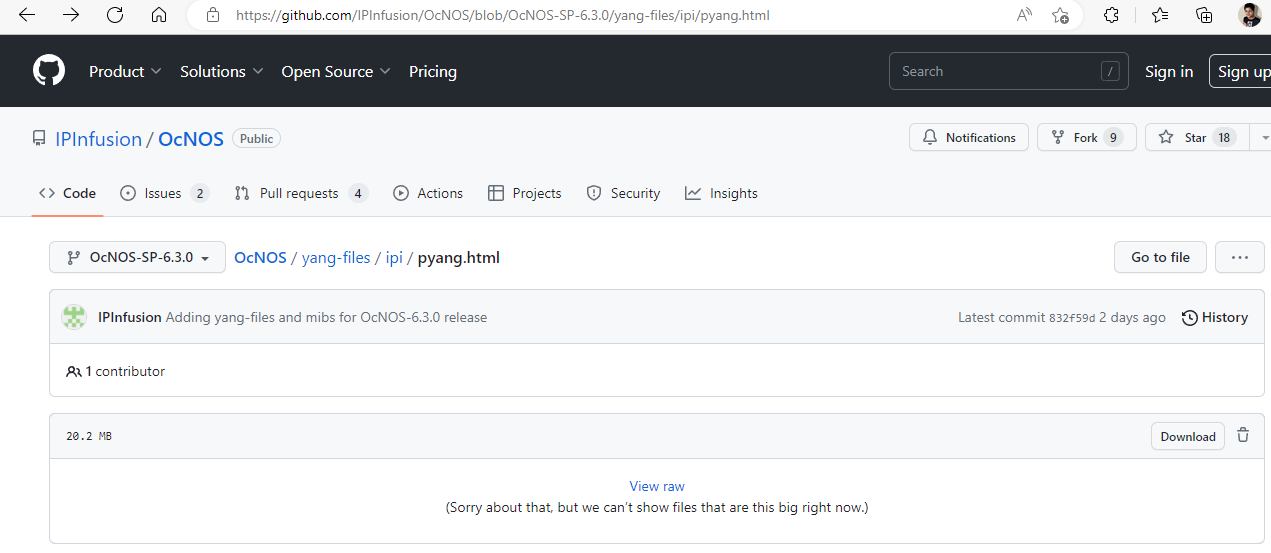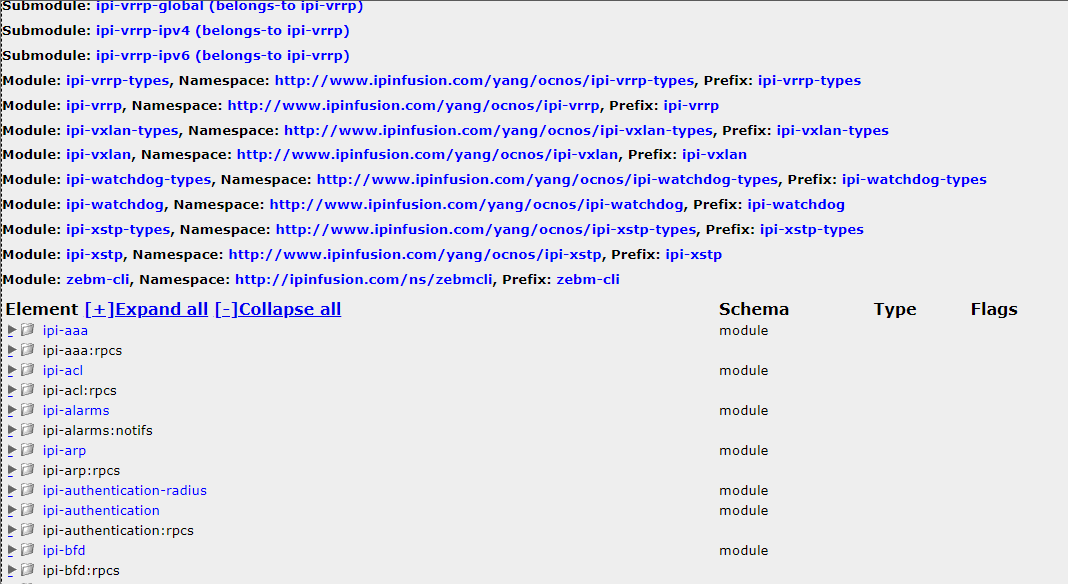2. Get the datamodels
The datamodels can be retrieved from the following locations:
• Github
• OcNOS installed devices.
2.1 Datamodel Location in Github
Users can access the YANG data models on GitHub through the following link: GitHub - IPInfusion/OcNOS: OcNOS™ Network Operating System
Note: This link directs to the 'master' branch, which may not always be the latest or up to date. To access specific YANG models based on OcNOS release version, follow these steps:
• Click on ‘master’.
• From the dropdown menu, enter a search string, such as "5.1," "6.0.0," or "6.3.0," corresponding to the OcNOS release version for which the YANG models are needed.
• Select the desired version from the dropdown and click to switch the branch.
Before proceeding, refer to the snapshot below to understand how to choose the branch version:

2.1.1 Yang Datamodels
The Yang models are available inside the “yang-files” folder. OcNOS supports two types of Datamodels:
1. IPI Datamodels
2. OpenConfig datamodels
Here is a snapshot for reference:

2.1.2 IPI Datamodels
OcNOS supports the IPI Datamodels, which are considered the 'native' datamodels. These models are used to represent all configurations and operational attributes of OcNOS. The IPI Datamodels adhere to OpenConfig style guidelines, ensuring a clear separation of 'config' and 'state' attributes. User can find these datamodels inside the "yang-files/ipi" folder on GitHub. Here is a snapshot for reference:

2.1.2.1 IPI Pyang Tree
To access the Pyang Trees, follow these steps:
1. Scroll down to the bottom of the page and click on “pyang.html”.
2. On the Pyang page, right-click on 'view raw' and choose 'Save link as...' Do not select ‘Download’.
Refer to the snapshot below:

3. After saving the pyang HTML page, user can access the Pyang tree. Once the page is open, scroll down to find the individual datamodel pyang trees. Refer to the snapshot below:

2.1.3 OpenConfig Datamodels
OcNOS supports both native IPI models and OpenConfig standard-defined datamodels. Not all attributes of OpenConfig are supported. Some additional attributes are added in OpenConfig for operational purposes, which are defined in the IPI OpenConfig deviation yang files.
To use OpenConfig datamodels, users must combine IPI deviation files with OpenConfig yang files. Here's how to do it:

• Obtain the deviation files from the "yang-files/openconfig" folder on the IPInfusion GitHub.
• In this folder, a README file contains the OpenConfig SHA1 to be used.
• Previously, OpenConfig didn't have a release versioning. To get the files, use git:
git clone git@github.com:openconfig/public.git openconfig/
git checkout <SHA1 from README>
cd openconfig/release/models
After performing the git checkout, find the yang files in the "openconfig/release/models" folder.
Note: OpenConfig has now added versioning support and future OcNOS releases will align with OpenConfig's released versions.
Not all attributes of the OpenConfig datamodels are supported, and there are some variations in the ones that are supported. Detailed information is tabulated in the 'yang deviation' files located within the "yang-files/openconfig" folder.
2.1.3.1 OpenConfig Pyang Tree
The Pyang Tree for OpenConfig can also be found on GitHub under "yang-files/openconfig/openconfig.html.
To download the HTML file and open it, follow the same instructions provided in section 2.1.2.1 for IPI Pyang Tree.
This provides a consolidated view of OpenConfig support in OcNOS, including only the attributes that are supported, by incorporating the yang deviations. Refer to the snapshot below for guidance.

2.2 Datamodel Location in the device
After the installation of OcNOS, all Yang models are loaded onto the device and can be found in the following location:
OcNOS#start-shell
bash-5.0$ cd /usr/share/yuma/modules
bash-5.0$ ls
ipi netconfcentral openconfig yang
bash-5.0$ find . | sed -e "s/[^-][^\/]*\// |/g" -e "s/|\([^ ]\)/|-\1/"
.
|-ipi
tfo
ipi-tfo.yang
ipi-tfo-types.yang
network-instance
ipi-network-instance.yang
ipi-network-instance-types.yang
common
.....
Use the "find" command to explore the available models further.
Last modified date: 10/20/2023